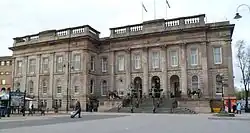| St John's Church, Dukinfield | |
|---|---|
 St John's Church, Dukinfield, from the west | |
 St John's Church, Dukinfield Location in Greater Manchester | |
| 53°28′38″N 2°04′21″W / 53.4771°N 2.0726°W | |
| OS grid reference | SJ 952,978 |
| Location | Dukinfield, Greater Manchester |
| Country | England |
| Denomination | Anglican |
| Website | St John's, Dukinfield |
| History | |
| Status | Parish church |
| Founded | 3 September 1838 |
| Dedication | St John the Evangelist |
| Consecrated | 24 May 1841 |
| Architecture | |
| Functional status | Active |
| Heritage designation | Grade II |
| Designated | 6 February 1986 |
| Architect(s) | Edmund Sharpe |
| Architectural type | Church |
| Style | Gothic Revival |
| Groundbreaking | 1838 |
| Completed | 1840 |
| Construction cost | £3,299 |
| Specifications | |
| Materials | Stone, slate roof |
| Administration | |
| Province | York |
| Diocese | Chester |
| Archdeaconry | Macclesfield |
| Deanery | Mottram |
| Parish | St John the Evangelist, Dukinfield |
| Clergy | |
| Vicar(s) | Revd Tim Hayes |
St John's Church is in Oxford Road, Dukinfield, Greater Manchester, England. It is an active Anglican parish church in the deanery of Mottram, the archdeaconry of Macclesfield and the diocese of Chester.[1] The church is recorded in the National Heritage List for England as a designated Grade II listed building.[2] It stands in an elevated position at the top of a small hill.[3]
History
St John's is a Commissioners' church designed by the Lancaster architect Edmund Sharpe, and built in 1838–40.[4] The church cost £3,299 (equivalent to £320,000 in 2021)[5] to build and £2,599 of this was met by a grant from the Church Building Commission.[6] The foundation stone was laid on 3 September 1838, the same day as that at St George's Church, Stalybridge, also designed by Sharpe. It was consecrated on 24 May 1841 by Rt Revd John Bird Sumner, who was at that time the Bishop of Chester. The church opened for worship in July.[3] It provided seating for 1,234 people.[7] Fifty years later the church was restored, with little alteration other than the addition of two windows to the chancel.[3]
Rayner Stephens was buried in the graveyard.[8]
Architecture
The church is built in stone with a slate roof. Its plan consists of a five-bay nave with north and south aisles, a short single-bay chancel, and a tower at the west end. The tower is in four stages, it has a west door, and at the top is a coped parapet and pinnacles. A coped parapet also runs along the walls and gables of the church. The windows are paired lancets. Inside the church are galleries on three sides. The galleries and the nave arcades are supported by octagonal columns. The organ is in the west gallery.[2][4]
See also
References
- ↑ Dukinfield, St John the Evangelist, Church of England, retrieved 26 March 2010
- 1 2 Historic England, "Church of St John the Evangelist, Trafford (1068017)", National Heritage List for England, retrieved 27 May 2012
- 1 2 3 Hughes, John M. (2010), Edmund Sharpe: Man of Lancaster, John M. Hughes, p. 163
- 1 2 Hartwell, Clare; Hyde, Matthew; Hubbard, Edward; Pevsner, Nikolaus (2011) [1971], Cheshire, The Buildings of England, New Haven and London: Yale University Press, pp. 336–337, ISBN 978-0-300-17043-6
- ↑ UK Retail Price Index inflation figures are based on data from Clark, Gregory (2017), "The Annual RPI and Average Earnings for Britain, 1209 to Present (New Series)", MeasuringWorth, retrieved 11 June 2022
- ↑ Port, M. H. (2006), 600 New Churches: The Church Building Commission 1818–1856 (2nd ed.), Reading: Spire Books, p. 331, ISBN 978-1-904965-08-4
- ↑ Brandwood, Geoff; Austin, Tim; Hughes, John; Price, James (2012), The Architecture of Sharpe, Paley and Austin, Swindon: English Heritage, p. 211, ISBN 978-1-84802-049-8
- ↑ "A Tribute to Joseph Rayner Stephens (1805 -1879)". www.tameside.gov.uk. Tameside Metropolitan Borough Council. Retrieved 7 April 2021.


